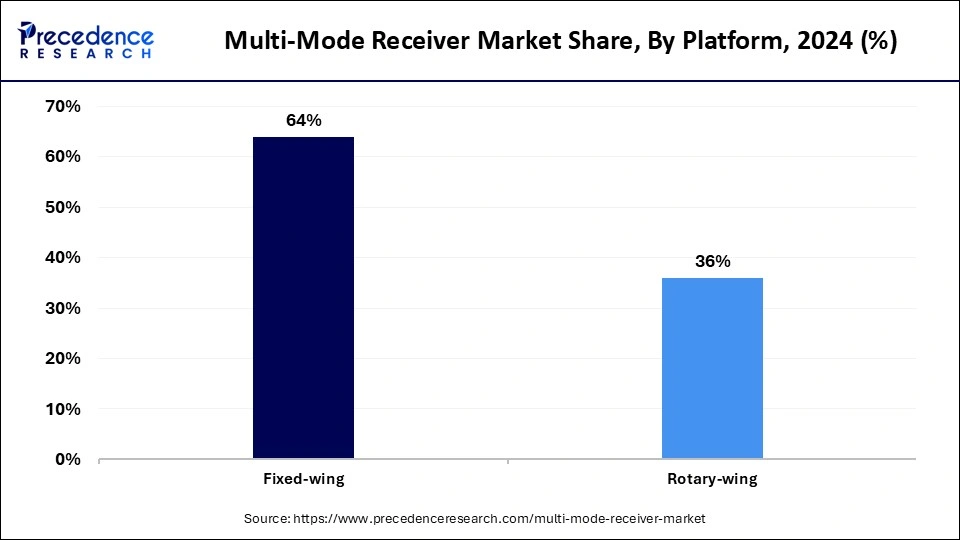April 2023
The global multi-mode receiver market size is calculated at USD 1.65 billion in 2025 and is forecasted to reach around USD 2.39 billion by 2034, accelerating at a CAGR of 4.24% from 2025 to 2034. The North America market size surpassed USD 600 million in 2024 and is expanding at a CAGR of 4.37% during the forecast period. The market sizing and forecasts are revenue-based (USD Million/Billion), with 2024 as the base year.
The global multi-mode receiver market size accounted for USD 1.58 billion in 2024 and is predicted to increase from 1.65 billion in 2025 to approximately USD 2.39 billion by 2034, expanding at a CAGR of 4.24% from 2025 to 2034. The capability of multi-mode receivers to combine and accumulate multiple navigation functionalities is the key factor driving market growth. Also, innovations in semiconductor technology, coupled with the surging number of air passengers across the globe, can fuel market growth further.

Artificial Intelligence, especially machine learning, plays an important role in the multi-mode receiver market, improving reliability and performance by facilitating innovative signal processing and tackling impairments such as phase noise and IQ imbalance. Furthermore, AI algorithms like SVM (Support Vector Machine) are utilized to develop robust and computationally efficient demodulation techniques.
The U.S. multi-mode receiver market size was exhibited at USD 420 billion in 2024 and is projected to be worth around USD 650 billion by 2034, growing at a CAGR of 4.46% from 2025 to 2034.

North America dominated the multi-mode receiver market in 2024. The dominance of the region can be attributed to the growing use of next-generation navigation technologies, such as ILS, GLS, and GNSS systems, that ensure precise and smooth flight operations, hence impacting positive market growth. Furthermore, defense forces and commercial airlines are heavily investing in the modernization of fleets.
U.S. Market Trends
In North America, the U.S. led the multi-mode receiver market owing to the rising demand for the latest narrow-body aircraft from consumers across the globe, along with the increasing emphasis of multiple market players on innovating existing fleets. The country is also home to various aviation technology companies.
Asia Pacific is expected to grow at the fastest rate in the multi-mode receiver market over the period studied. The growth of the region can be credited to the increasing implementation of satellite-based systems such as GLS and ground-based augmentation systems (GBAS) in the region. Moreover, a substantial rise in demand for the latest consumer-connected devices technology in the region is propelling regional growth.

China Market Trends
In Asia Pacific, China dominated the multi-mode receiver market. The dominance of the country can be linked to the increasing demand for wearables created by major market players in the country. Major consumer electronics players in the country are increasingly focusing on developing advanced devices.
A multi-mode receiver is a unit with numerous functions that involve all the onboard receiving practices that are needed for a pilot to position, navigate, and land an aircraft. It offers an efficient and cost-effective solution for advanced facilities with enhanced avionics. The multi-mode receiver includes various stand-alone receivers like microwave landing system (MLS) receivers, landing system (ILS) receivers, and GPS landing system receivers in single units of the aircraft industry.
| Report Coverage | Details |
| Market Size by 2034 | USD 2.39 Billion |
| Market Size in 2025 | USD 1.65 Billion |
| Market Size in 2024 | USD 1.58 Billion |
| Market Growth Rate from 2025 to 2034 | CAGR of 4.24% |
| Dominated Region | North America |
| Fastest Growing Market | Asia Pacific |
| Base Year | 2024 |
| Forecast Period | 2025 to 2034 |
| Segments Covered | Platform, Fit, Application, End Use, and Regions |
| Regions Covered | North America, Europe, Asia-Pacific, Latin America and Middle East & Africa |
Surge in fleet expansion
The rising global air traffic has become a major growth factor for the multi-mode receiver market. Passenger density is increasing frequently, particularly in developing economies like India and China, where the middle-class population, along with the family income, is surging. In addition, this growth has led to a surge in demand for air travel, allowing airlines to expand their fleets and add new routes.
Potential cybersecurity threats
As aircraft are majorly dependent on satellite-based systems and digital technologies, cybersecurity has emerged as a crucial obstacle for the multi-mode receiver market. These receivers are integral to landing capabilities and aircraft navigation. However, their dependence on real-time data transmission, satellite signals, and digital integration makes them vulnerable to cyberattacks.
Increasing shift towards integrated solutions
There is a rising trend of bringing multichannel receivers into more compact and smaller units within all sectors of industries. Wearables and smartphones, particularly car systems, are impacted by the utilization of a multi-mode receiver for networks like GPS/Wi-Fi/Bluetooth. Furthermore, in the automobile sector, multi-mode receivers optimize innovative autonomous vehicles and driver-assistance systems (ADAS), offering smoother navigation.
The fixed-wing segment held the largest multi-mode receiver market share in 2024. The dominance of the segment can be attributed to the increasing use of these receivers in the aviation system. The multi-mode system is designed for aircraft that create lift through fixed wings. Additionally, fixed-wing platform receivers play a crucial role in the smooth operations of the aviation industry.

The rotary-wing segment is anticipated to grow at the fastest rate over the forecast period. The growth of the segment can be credited to the growing use of helicopters by many industries, including aerospace, transportation, critical infrastructure management, and defense. Moreover, these receivers are utilized in aircraft that use rotating blades to develop lift, which is essential for takeoff.
The line-fit segment dominated the multi-mode receiver market in 2024. The dominance of the segment can be linked to the integration of multi-mode receivers in new aircraft during manufacturing. In addition, original equipment manufacturers (OEMs) and airlines prefer line-fit solutions because they ensure smooth compatibility with innovative avionics systems.
The retrofit segment is expected to grow at the fastest rate over the forecast period. The growth of the segment can be driven by the ongoing fleet upgrade projects launched by various airline industry participants. Furthermore, these latest agreements include the addition of advanced Satellite Augmentation Systems and Air Traffic Services Units (ATSU), etc.
The navigation and positioning segment held the largest multi-mode receiver market share in 2024. The dominance of the segment is owing to the increasing incidences of harsh weather conditions, which leads to delays in workloads on pilots. Furthermore, the multi-mode receiver is mainly deployed to receive various signals from numerous systems and technologies, leading to segment expansion soon.
The landing applications segment is estimated to grow at the fastest rate during the projected period. The growth of the segment is due to the rising need for innovative technology-assisted guidance systems along with the increasing prevalence of landing delays caused due to harsh weather. Also, rising traffic at busy airports is impacting positive market segment growth.
In 2024, the aerospace and defense segment dominated the multi-mode receiver market by holding the largest share. The dominance of the segment can be credited to the rising use of innovative multi-mode receivers in business airline fleets, commercial airline fleets, and defense aircraft. The defense and aerospace industry depends on smooth technology assistance for landings, lifts, and security protocol adherence.
The telecommunication segment is projected to grow at the fastest rate during the forecast period. The growth of the segment is because of the increasing use of connected devices technology and the surge in the ubiquity of smartphones. Moreover, the use of these receivers in automotive applications for different functionscan propel segment growth further.

By Platform
By Fit
By Application
By End-Use
By Geography
For inquiries regarding discounts, bulk purchases, or customization requests, please contact us at sales@precedenceresearch.com
No cookie-cutter, only authentic analysis – take the 1st step to become a Precedence Research client
April 2023
October 2024
August 2024